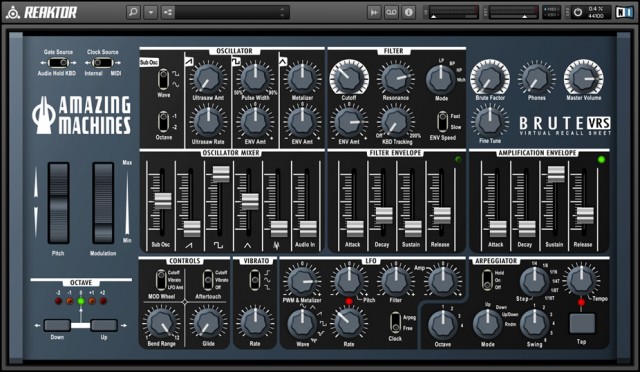
Amazing Machines has introduced BRUTE VRS, a virtual patch recall app for the Arturia Minibrute synthesizer.
The Minibrute is old-school when it comes to patch memory – you have to write them down and you recall patches by moving all the knobs to the ‘saved’ posiitons.
BRUTE VRS doesn’t automate this, but it lets you create a screen representation of your Minibrute patches and then save them for recall. Here’s what they have to say about it:
Although the BRUTE VRS does not generate any sound on it’s own, special attention to detail has been taken to achieve visual feedback that is as close as possible to the hardware instrument, including the LEDs for Octave Selection, Envelopes, LFO and Arpeggiator Tempo.
The Pitch and Mod Wheels respond to incoming MIDI Data from your MINIBRUTE, while the Envelopes’ LEDs blink, in a similar fashion to the hardware, when notes are played and depending on how the Envelopes are set. The Arpeggiator Tempo can be Synced to your DAW’s Tempo using the Clock Source Switch. This level of detail may sound trivial at first, for a simple Virtual Recall Sheet, but it’s essential to allow the end user to store and load patches fast and easy.
Here’s a demo of BRUTE VRS in action:
https://www.youtube.com/watch?v=MnCLw_y7RPo
Features:
- 1 Reaktor Ensemble
- Virtual representation of every single parameter on the hardware instrument
- Virtual representation of all the blinking LEDs, as close as possible to hardware response
- Use software instead of paper to store your patches
Compatibility:
Native Instruments’ Reaktor or Reaktor Player, version 5.8 or newer
Pricing and Availability:
BRUTE VRS is available for US $14.99.

Where is DEMO
Or maybe you can use your phone to take a picture…
And invite a friend for some beers whit the 15$
Telephone screens are tiny. I have trouble seeing the text on a 21″ monitor sometimes. Do you seriously think you look cool scrolling through your magnified cell phone screen for ten minutes while the audience waits for some sort of sound to start happening?
I’ll wait for a servo-actuated device that connects robotic controls to the knobs and sliders of the Minibrute so that the computer can control it directly. Yeah, it would be expensive, or not depending on if you are clever enough to print it all yourself in a 3D printer, make it pneumatic for quiet and safety and reliability. Roboticize your analog synth 1950s old school Asimovian style. That would out-hip Thomas Dolby.
You take the photos with the phone, then open then on the computer.. It’s not rocket appliances
Use your brain and a patch sheet. People have managed for decades using analogue synths without the aid of presets. There are people that can dial in a patch on a mono/poly or ms20 or pro 1 or model d. Etc. Yet you struggle with a micrrobrute! There is something seriously wrong there.
I think I would try to start modelling the oscillators and filters using reaktor and start trying to build a Mini-Brute emulation. This GUI looks great.
Nice I have it and now can control and save my own patches in Studio One!! congrats!
So i guess you’d hace to recreate the patch all over again, a bit time consuming but maybe you’ll learn it faster that way. Nice effort though.
Seems like someone put a lot of work into this.. All for not?
A Microbrute one would be lovely 😉
I’ve created my own make-shift version of this for the MicroBrute on the iPad. In TouchOSC, I simply recreated the GUI of the MicroBrute; once I have a patch created on the hardware I like, I recreate it in TouchOSC (realize, of course, nothing is getting transferred either way) so I can see where my knobs/sliders/switches are set. Take a screenshot, and I’m good to go.
Example screenshot here: http://www.achievednothing.com/microbrute.gif
I like this better than the reaktor version, the iPad is more immediate and can be sat next to the synth, plus your using touch and don’t need to go reaching for the mouse. It’s very crisp and clear too, good idea with this!
Here’s a copy of the layout if anyone wants it:
http://www.achievednothing.com/MicroBrute.touchosc.zip
Gotta have TouchOSC, though. Hope that can help anyone.
make it an ios app and it’d bee cool. make it an ios app with image recognition (to convert photos to presets) and it’d be awesome. otherwise i see no point in this “app”
WOW !! A notice book for Minibrute !! 15$ only !!!
This is FREE
http://bradyjacobsen.com/microbrute/
This’d be a good use of photo-recognition technology. Shoot a pic of the synth setup. PR engine renders this to a screen graphic that can be archived. Call up a graphic then point the camera at the synth. PR engine to the stored graphic and allows you to null the controls against the store setup.
If anyone wants to implement this, we can discuss royalty arrangements….
I actually enjoy going oldschool with the preset sheets sold by Arturia. Parameters are set a lot faster and more precise than by looking at a screen, then the MB, then screen… Also you can “store” variations of a preset by using non-permanent markers in different colours. Only drawback is that the sheets not cheap.
This would take way longer than taking a picture. Anyone serious should use a tablet if you are worried about screen size on phones. Just snap it and be done with it.
Simplest is the best. Take a photo!
I can understand the niceness of having a folder of sheets but don’t think I want to spend the time.